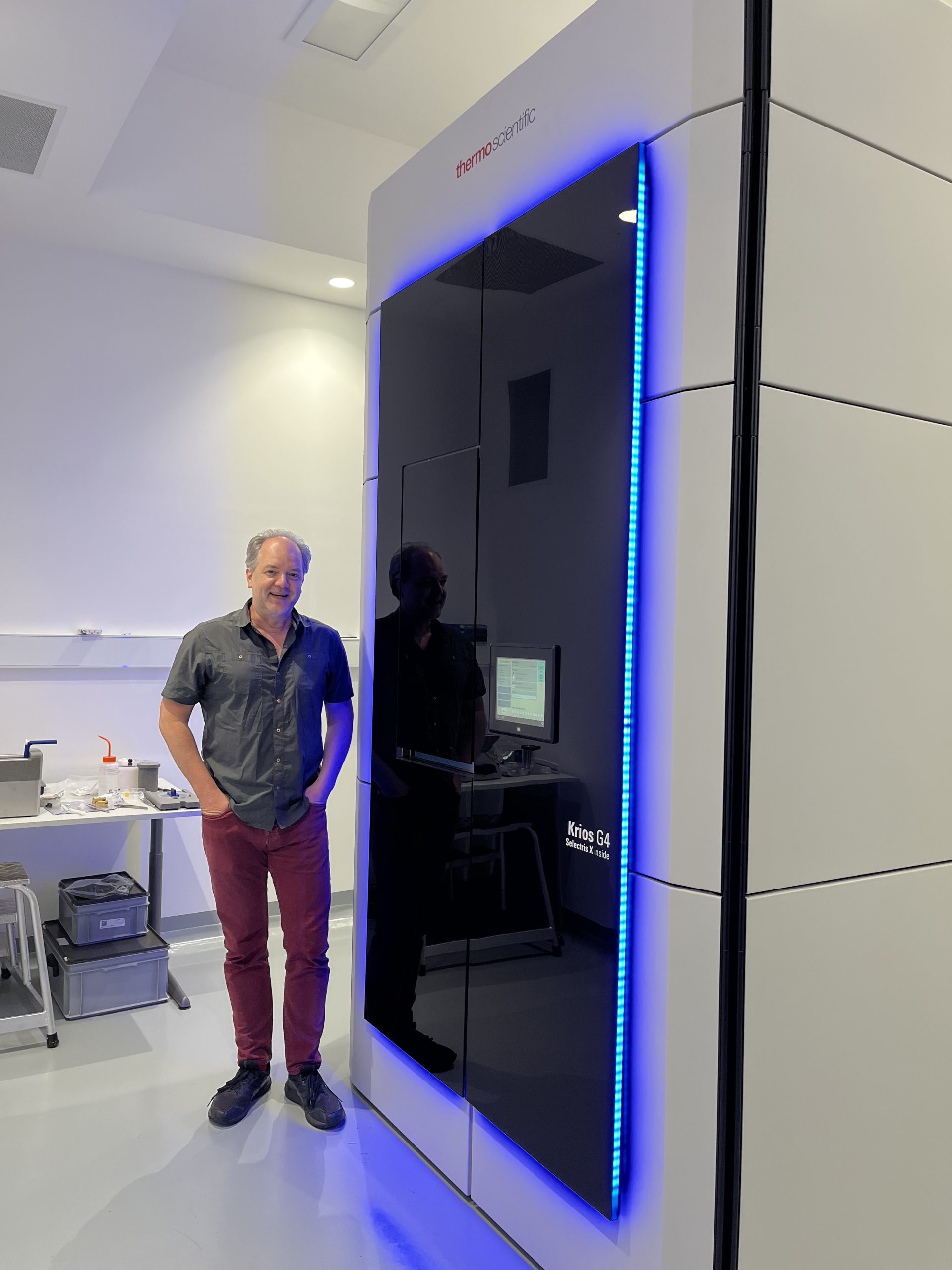Microscopy is a fundamental technique for biomedical research. The Titan Krios G4’s record-breaking resolutions and ‘in-situ structural biology’ capabilities will allow researchers to delve deeper into the molecular architecture of our bodies, providing crucial insights for disease prevention, management, and cure.
Funded by Microscopy Australia — enabled by the National Collaborative Research Infrastructure Strategy (NCRIS) — the Victorian Higher Education State Investment Fund (VHESIF) and Monash University, the Titan Krios G4 is an exceptional addition to the Australian national microscopy capability. EMBL Australia, Microscopy Australia, Chan Zuckerberg Initiative, and CRYOZ will host a five-day cryo-electron tomography masterclass in conjunction with the launch of the instrument.

Centre director A/Prof. Georg Ramm with the new Titan Krios G4
The Titan Krios G4, developed by Thermo Fisher Scientific, has achieved record-breaking resolutions in biological imaging. It will provide a significant step-change in Australia’s capability to perform high-resolution cryo-electron tomography (cryo-ET), a technique that bridges the gap between cell and structural biology. When combined with subtomogram averaging it allows to determine molecular structures where they sit inside the cell. In addition, the Krios will provide an uplift capability for single particle analysis, and increase capacity for emerging techniques such as microcrystal-electron diffraction (microED).
Australian researchers can now effectively compete with researchers overseas and use cryo-EM and cryo-ET to see biological samples at near-atomic resolution, driving advances in biomedicine.
Currently, the most intensive users of the new Krios G4 as well as the previous generation Krios G1 are the world-leading experts at the Monash Biomedicine Discovery Institute (BDI). Their use of the Krios platforms will continue to underpin discoveries in infectious diseases, antibiotic resistance, cancer, heart disease, neurological diseases and much more.
A/Prof. Georg Ramm, Director of the Ramaciotti Centre for Cryo-EM and a Lab Head at the Monash BDI, will be using the instrument as part of his Chan Zuckerberg Initiative imaging scientist grant. The project aims to develop workflows for cryo-tomography in tissues so that researchers can study tissues’ molecular architecture in health and disease. A/Prof. Ramm will work directly with collaborators to use cryo-tomography to answer fundamental biomedical questions and teach these new techniques to cell and structural biologists.
The launch of the Titan Krios G4 represents a leap forward in our ability to reveal the fundamental building blocks of the body, knowledge that is essential for driving biomedical research and innovation in Australia.
About Microscopy Australia
Microscopy Australia provides researchers and industry with access to the nation’s largest range of high-end microscopes, microanalysis tools, and specialists. It consists of university-based microscopy centres around the country and is funded by the National Collaborative Research Infrastructure Strategy (NCRIS), state governments and host institutions. Microscopy Australia’s open access policy means that researchers anywhere in Australia can access any of our facilities, giving researchers access to instruments they may not have at their home institution. Our instruments have dedicated experts to deliver high-quality training and support to ensure the best possible outcomes.
About the Victorian Higher Education State Investment Fund
This $350 million fund supports universities with capital works, applied research and research infrastructure focused on boosting Victoria’s productivity and the economy as the state recovers from the impacts of COVID-19, which hit universities hard.
About the Monash Biomedicine Discovery Institute
Committed to making the discoveries that will relieve the future burden of disease, the Monash Biomedicine Discovery Institute (BDI) at Monash University brings together more than 120 internationally-renowned research teams. Spanning seven discovery programs across Cancer, Cardiovascular Disease, Development and Stem Cells, Infection, Immunity, Metabolism, Diabetes and Obesity, and Neuroscience, Monash BDI is one of the largest biomedical research institutes in Australia. Our researchers are supported by world-class technology and infrastructure, and partner with industry, clinicians and researchers internationally to enhance lives through discovery
About the Ramaciotti Centre for Cryo-EM
The Monash Ramaciotti Centre for Cryo-Electron Microscopy is a leading research facility for biological electron microscopy. The centre provides expertise in advanced electron microscopy for biomedical discoveries at the molecular and cellular level. It offers a range of EM techniques from scanning electron microscopy (SEM) and transmission electron microscopy (TEM) to immuno-electron microscopy, correlative light and electron microscopy, cryo-electron tomography and structure determination using single particle cryo-EM and subtomogram averaging. The microscope suite includes eight advanced electron microscopes, among them two Titan Krios (G1 and G4), cryo-FIB-SEM Helios 5, and cryo-pFIB Helios Hydra. Read more about the impact of this facility in ‘Seeing is Believing: Celebrating 10 Years of Impact at the Ramaciotti Centre for Cryo-EM’.
May 23, 2024